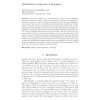125
Voted
JMLR
2010
14 years 7 months ago
2010
Probabilistic grammars offer great flexibility in modeling discrete sequential data like natural language text. Their symbolic component is amenable to inspection by humans, while...
94
Voted
CORR
2011
Springer
14 years 8 months ago
2011
Springer
Existing grammar frameworks do not work out particularly well for controlled natural languages (CNL), especially if they are to be used in predictive editors. I introduce in this p...
117
Voted
EMNLP
2010
14 years 11 months ago
2010
This paper addresses the problem of learning to map sentences to logical form, given training data consisting of natural language sentences paired with logical representations of ...
118
Voted
GRAMMARS
1998
15 years 22 days ago
1998
From the perspective of the linguist, the theory of formal languages serves as an abstract model to address issues such as complexity, learnability, information content, etc. which...
205
Voted
DEBU
2007
15 years 1 months ago
2007
The volume of information in natural languages in electronic format is increasing exponentially. The demographics of users of information management systems are becoming increasin...
101
Voted
CNL
2009
15 years 2 months ago
2009
Controlled natural languages (CNL) and computational semantics in general do not address word sense disambiguation, i.e., they tend to interpret only some functional words that are...
118
Voted
ANLP
1994
15 years 2 months ago
1994
We present the advantages of guided sentences composition for communicating in natural language with computers. We show how guidance can be achieved by means of the partial synthe...
113
click to vote
ACL
2006
15 years 2 months ago
2006
We propose a new hierarchical Bayesian n-gram model of natural languages. Our model makes use of a generalization of the commonly used Dirichlet distributions called Pitman-Yor pr...
100
Voted
MEDINFO
2007
15 years 2 months ago
2007
Objectives: To discuss the relationships between ontologies, terminologies and language in the context of Natural Language Processing (NLP) applications in order to show the negat...
125
click to vote
IFIP12
2007
15 years 2 months ago
2007
In this paper an efficient architecture for natural language processing is presented, implemented in hardware using FPGAs (Field Programmable Gate Arrays). The system can receive s...



